Leadership and Theory: Vision, Communication, and Action
VerifiedAdded on 2022/09/09
|8
|2045
|18
Essay
AI Summary
This essay delves into the critical role of leadership and vision in achieving organizational goals. It emphasizes the importance of a clear vision, effective communication, and consistent action in driving success. The essay highlights the significance of aligning organizational goals with stakeholder expectations and fostering a collaborative environment. It examines how visionary leaders like Professor Gordon Edge communicated their ideas, encouraged innovation, and established strong communication systems to ensure employee commitment. The essay also analyzes the case of Generics Group, illustrating how a loss of vision and failure to adapt can lead to decline. It concludes by underscoring the need for leaders to set aspirational, yet achievable, goals and to motivate employees to contribute towards the overall success of the organization.
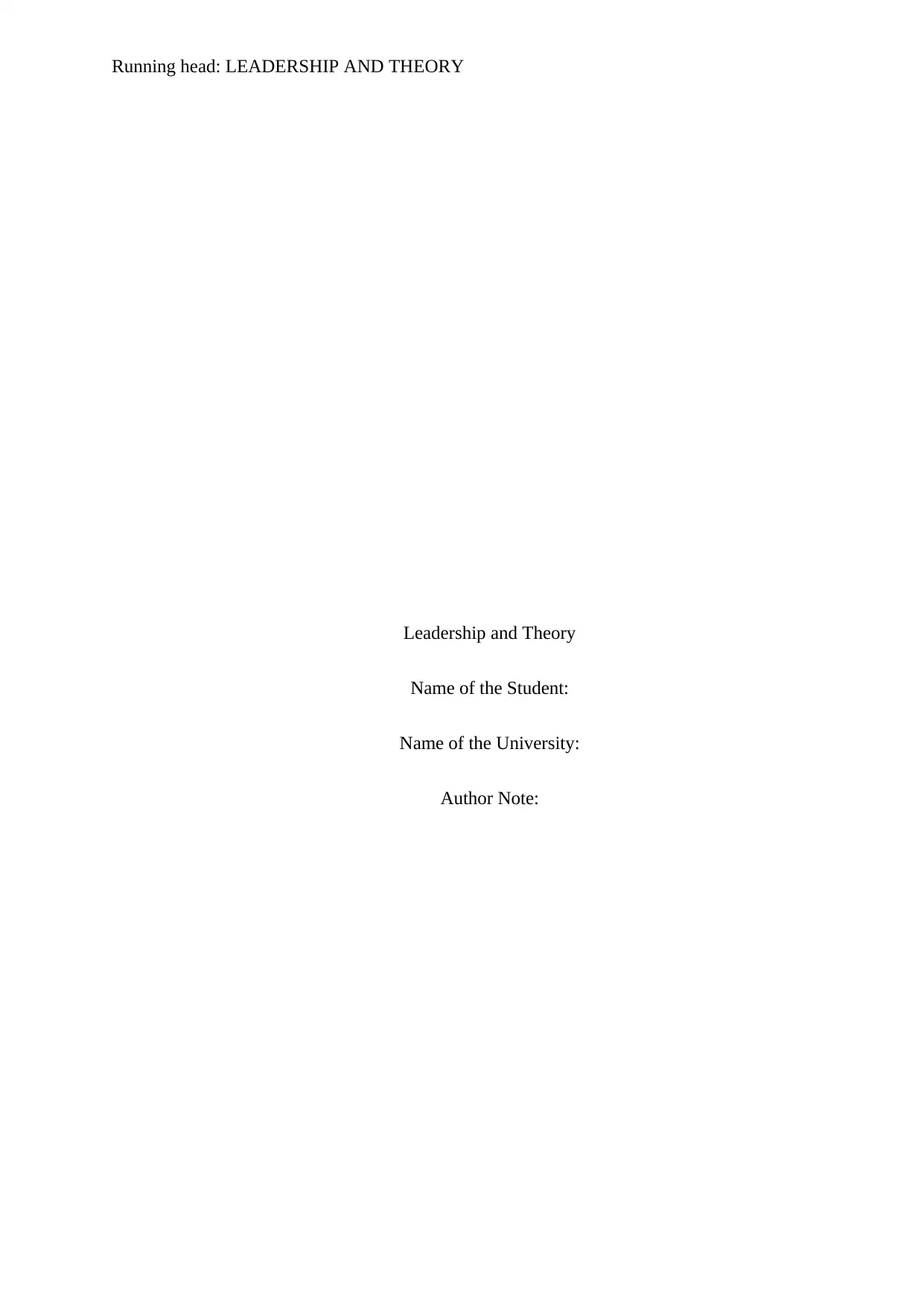
Running head: LEADERSHIP AND THEORY
Leadership and Theory
Name of the Student:
Name of the University:
Author Note:
Leadership and Theory
Name of the Student:
Name of the University:
Author Note:
Paraphrase This Document
Need a fresh take? Get an instant paraphrase of this document with our AI Paraphraser
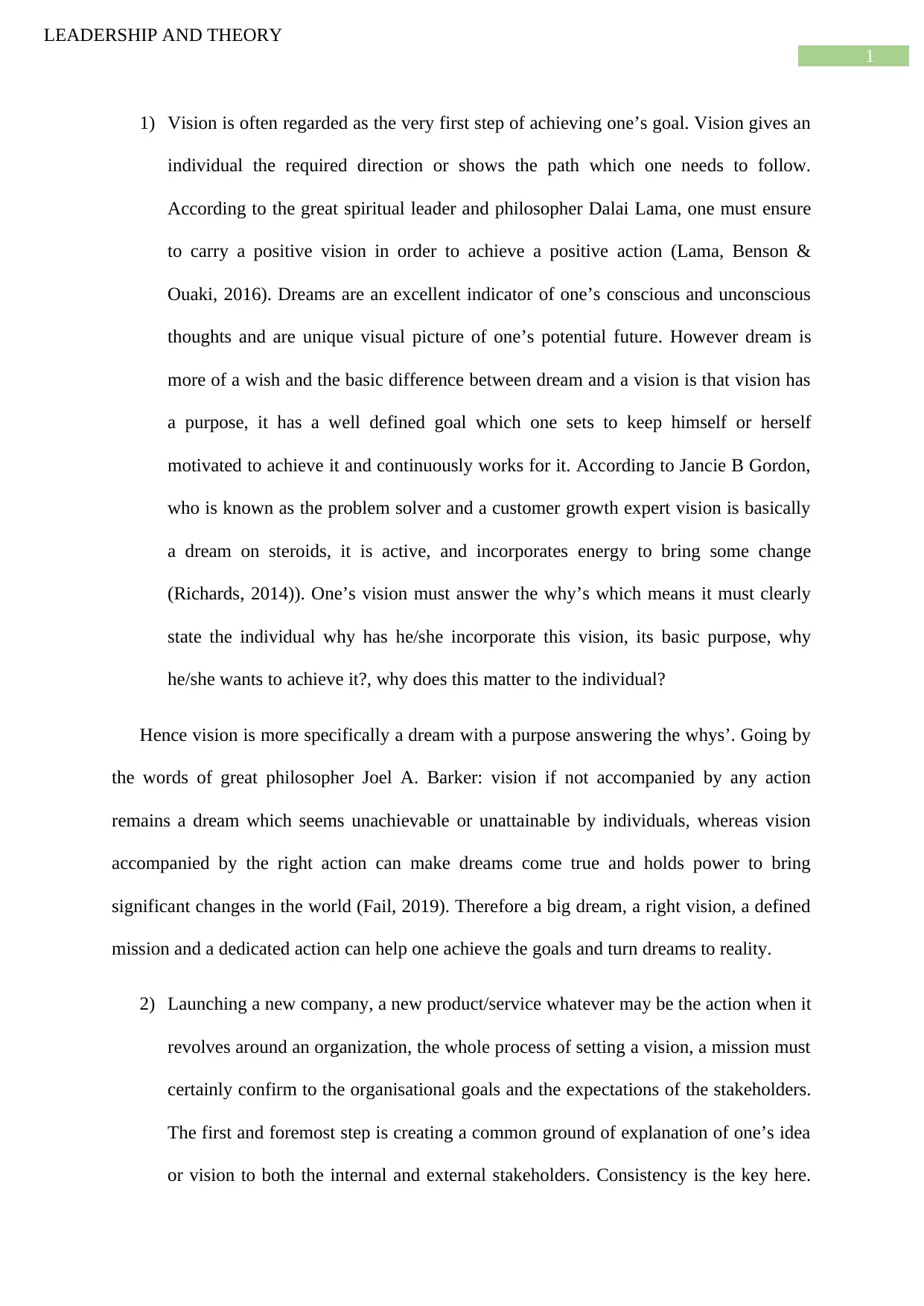
1
LEADERSHIP AND THEORY
1) Vision is often regarded as the very first step of achieving one’s goal. Vision gives an
individual the required direction or shows the path which one needs to follow.
According to the great spiritual leader and philosopher Dalai Lama, one must ensure
to carry a positive vision in order to achieve a positive action (Lama, Benson &
Ouaki, 2016). Dreams are an excellent indicator of one’s conscious and unconscious
thoughts and are unique visual picture of one’s potential future. However dream is
more of a wish and the basic difference between dream and a vision is that vision has
a purpose, it has a well defined goal which one sets to keep himself or herself
motivated to achieve it and continuously works for it. According to Jancie B Gordon,
who is known as the problem solver and a customer growth expert vision is basically
a dream on steroids, it is active, and incorporates energy to bring some change
(Richards, 2014)). One’s vision must answer the why’s which means it must clearly
state the individual why has he/she incorporate this vision, its basic purpose, why
he/she wants to achieve it?, why does this matter to the individual?
Hence vision is more specifically a dream with a purpose answering the whys’. Going by
the words of great philosopher Joel A. Barker: vision if not accompanied by any action
remains a dream which seems unachievable or unattainable by individuals, whereas vision
accompanied by the right action can make dreams come true and holds power to bring
significant changes in the world (Fail, 2019). Therefore a big dream, a right vision, a defined
mission and a dedicated action can help one achieve the goals and turn dreams to reality.
2) Launching a new company, a new product/service whatever may be the action when it
revolves around an organization, the whole process of setting a vision, a mission must
certainly confirm to the organisational goals and the expectations of the stakeholders.
The first and foremost step is creating a common ground of explanation of one’s idea
or vision to both the internal and external stakeholders. Consistency is the key here.
LEADERSHIP AND THEORY
1) Vision is often regarded as the very first step of achieving one’s goal. Vision gives an
individual the required direction or shows the path which one needs to follow.
According to the great spiritual leader and philosopher Dalai Lama, one must ensure
to carry a positive vision in order to achieve a positive action (Lama, Benson &
Ouaki, 2016). Dreams are an excellent indicator of one’s conscious and unconscious
thoughts and are unique visual picture of one’s potential future. However dream is
more of a wish and the basic difference between dream and a vision is that vision has
a purpose, it has a well defined goal which one sets to keep himself or herself
motivated to achieve it and continuously works for it. According to Jancie B Gordon,
who is known as the problem solver and a customer growth expert vision is basically
a dream on steroids, it is active, and incorporates energy to bring some change
(Richards, 2014)). One’s vision must answer the why’s which means it must clearly
state the individual why has he/she incorporate this vision, its basic purpose, why
he/she wants to achieve it?, why does this matter to the individual?
Hence vision is more specifically a dream with a purpose answering the whys’. Going by
the words of great philosopher Joel A. Barker: vision if not accompanied by any action
remains a dream which seems unachievable or unattainable by individuals, whereas vision
accompanied by the right action can make dreams come true and holds power to bring
significant changes in the world (Fail, 2019). Therefore a big dream, a right vision, a defined
mission and a dedicated action can help one achieve the goals and turn dreams to reality.
2) Launching a new company, a new product/service whatever may be the action when it
revolves around an organization, the whole process of setting a vision, a mission must
certainly confirm to the organisational goals and the expectations of the stakeholders.
The first and foremost step is creating a common ground of explanation of one’s idea
or vision to both the internal and external stakeholders. Consistency is the key here.
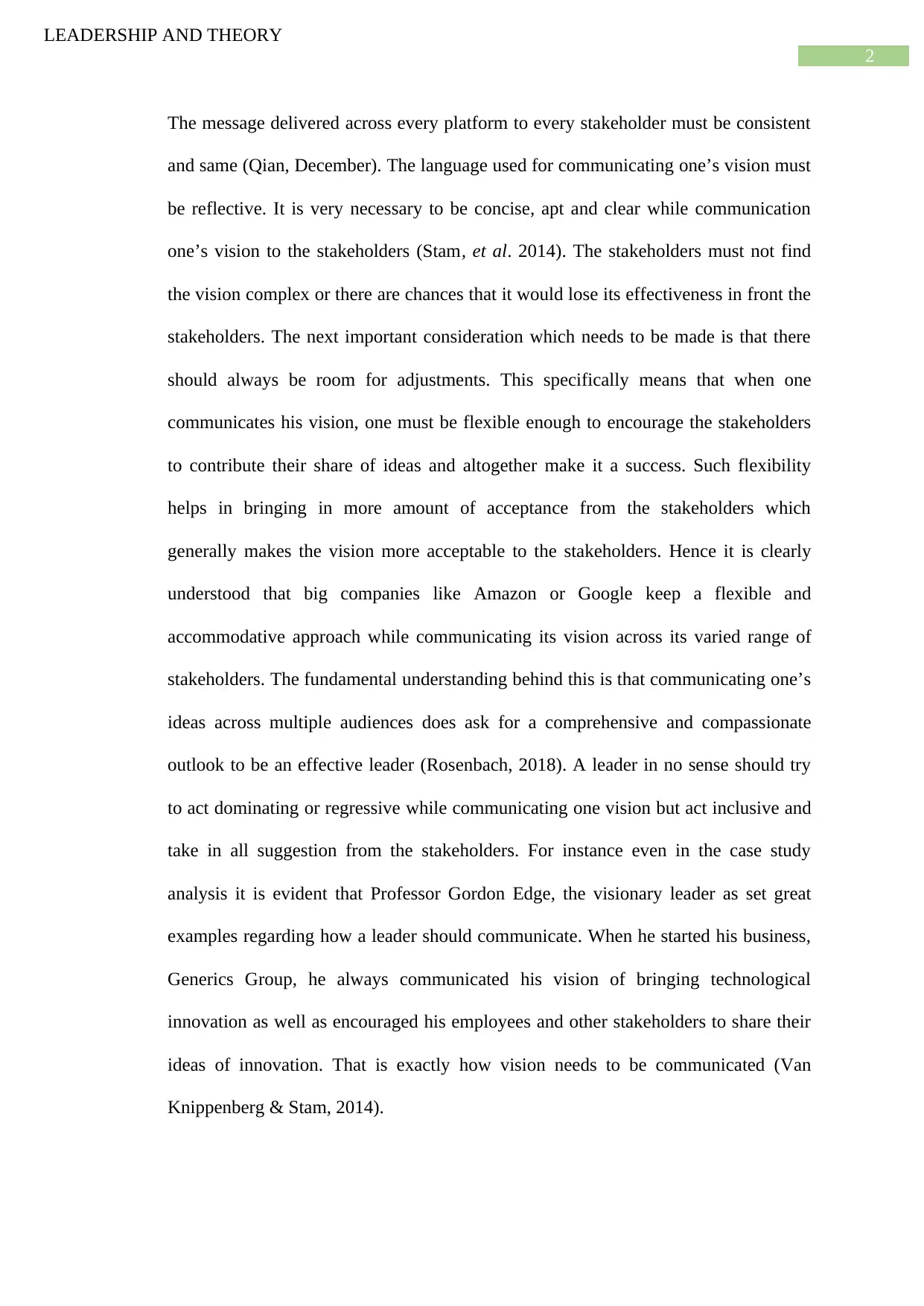
2
LEADERSHIP AND THEORY
The message delivered across every platform to every stakeholder must be consistent
and same (Qian, December). The language used for communicating one’s vision must
be reflective. It is very necessary to be concise, apt and clear while communication
one’s vision to the stakeholders (Stam, et al. 2014). The stakeholders must not find
the vision complex or there are chances that it would lose its effectiveness in front the
stakeholders. The next important consideration which needs to be made is that there
should always be room for adjustments. This specifically means that when one
communicates his vision, one must be flexible enough to encourage the stakeholders
to contribute their share of ideas and altogether make it a success. Such flexibility
helps in bringing in more amount of acceptance from the stakeholders which
generally makes the vision more acceptable to the stakeholders. Hence it is clearly
understood that big companies like Amazon or Google keep a flexible and
accommodative approach while communicating its vision across its varied range of
stakeholders. The fundamental understanding behind this is that communicating one’s
ideas across multiple audiences does ask for a comprehensive and compassionate
outlook to be an effective leader (Rosenbach, 2018). A leader in no sense should try
to act dominating or regressive while communicating one vision but act inclusive and
take in all suggestion from the stakeholders. For instance even in the case study
analysis it is evident that Professor Gordon Edge, the visionary leader as set great
examples regarding how a leader should communicate. When he started his business,
Generics Group, he always communicated his vision of bringing technological
innovation as well as encouraged his employees and other stakeholders to share their
ideas of innovation. That is exactly how vision needs to be communicated (Van
Knippenberg & Stam, 2014).
LEADERSHIP AND THEORY
The message delivered across every platform to every stakeholder must be consistent
and same (Qian, December). The language used for communicating one’s vision must
be reflective. It is very necessary to be concise, apt and clear while communication
one’s vision to the stakeholders (Stam, et al. 2014). The stakeholders must not find
the vision complex or there are chances that it would lose its effectiveness in front the
stakeholders. The next important consideration which needs to be made is that there
should always be room for adjustments. This specifically means that when one
communicates his vision, one must be flexible enough to encourage the stakeholders
to contribute their share of ideas and altogether make it a success. Such flexibility
helps in bringing in more amount of acceptance from the stakeholders which
generally makes the vision more acceptable to the stakeholders. Hence it is clearly
understood that big companies like Amazon or Google keep a flexible and
accommodative approach while communicating its vision across its varied range of
stakeholders. The fundamental understanding behind this is that communicating one’s
ideas across multiple audiences does ask for a comprehensive and compassionate
outlook to be an effective leader (Rosenbach, 2018). A leader in no sense should try
to act dominating or regressive while communicating one vision but act inclusive and
take in all suggestion from the stakeholders. For instance even in the case study
analysis it is evident that Professor Gordon Edge, the visionary leader as set great
examples regarding how a leader should communicate. When he started his business,
Generics Group, he always communicated his vision of bringing technological
innovation as well as encouraged his employees and other stakeholders to share their
ideas of innovation. That is exactly how vision needs to be communicated (Van
Knippenberg & Stam, 2014).
⊘ This is a preview!⊘
Do you want full access?
Subscribe today to unlock all pages.

Trusted by 1+ million students worldwide
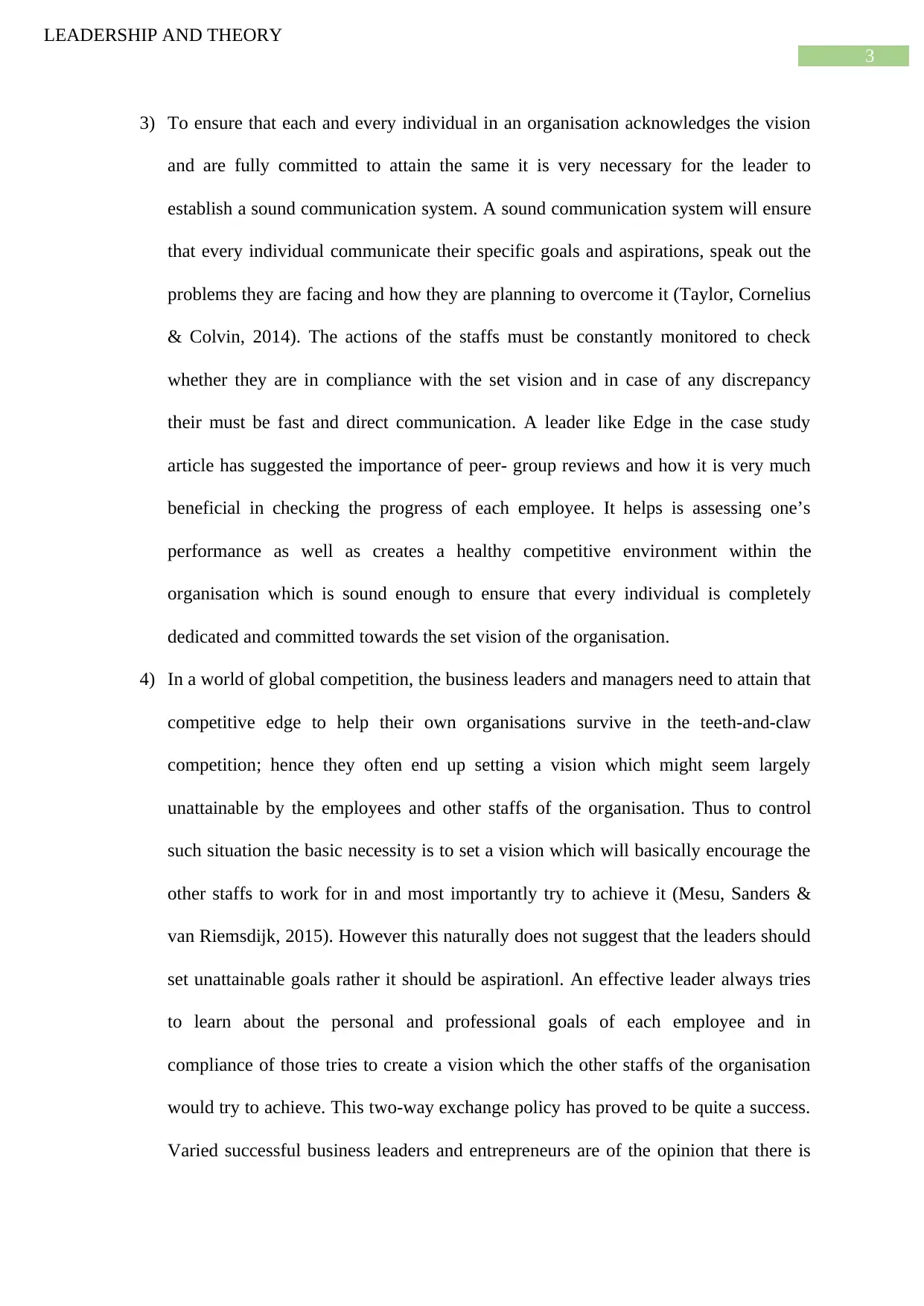
3
LEADERSHIP AND THEORY
3) To ensure that each and every individual in an organisation acknowledges the vision
and are fully committed to attain the same it is very necessary for the leader to
establish a sound communication system. A sound communication system will ensure
that every individual communicate their specific goals and aspirations, speak out the
problems they are facing and how they are planning to overcome it (Taylor, Cornelius
& Colvin, 2014). The actions of the staffs must be constantly monitored to check
whether they are in compliance with the set vision and in case of any discrepancy
their must be fast and direct communication. A leader like Edge in the case study
article has suggested the importance of peer- group reviews and how it is very much
beneficial in checking the progress of each employee. It helps is assessing one’s
performance as well as creates a healthy competitive environment within the
organisation which is sound enough to ensure that every individual is completely
dedicated and committed towards the set vision of the organisation.
4) In a world of global competition, the business leaders and managers need to attain that
competitive edge to help their own organisations survive in the teeth-and-claw
competition; hence they often end up setting a vision which might seem largely
unattainable by the employees and other staffs of the organisation. Thus to control
such situation the basic necessity is to set a vision which will basically encourage the
other staffs to work for in and most importantly try to achieve it (Mesu, Sanders &
van Riemsdijk, 2015). However this naturally does not suggest that the leaders should
set unattainable goals rather it should be aspirationl. An effective leader always tries
to learn about the personal and professional goals of each employee and in
compliance of those tries to create a vision which the other staffs of the organisation
would try to achieve. This two-way exchange policy has proved to be quite a success.
Varied successful business leaders and entrepreneurs are of the opinion that there is
LEADERSHIP AND THEORY
3) To ensure that each and every individual in an organisation acknowledges the vision
and are fully committed to attain the same it is very necessary for the leader to
establish a sound communication system. A sound communication system will ensure
that every individual communicate their specific goals and aspirations, speak out the
problems they are facing and how they are planning to overcome it (Taylor, Cornelius
& Colvin, 2014). The actions of the staffs must be constantly monitored to check
whether they are in compliance with the set vision and in case of any discrepancy
their must be fast and direct communication. A leader like Edge in the case study
article has suggested the importance of peer- group reviews and how it is very much
beneficial in checking the progress of each employee. It helps is assessing one’s
performance as well as creates a healthy competitive environment within the
organisation which is sound enough to ensure that every individual is completely
dedicated and committed towards the set vision of the organisation.
4) In a world of global competition, the business leaders and managers need to attain that
competitive edge to help their own organisations survive in the teeth-and-claw
competition; hence they often end up setting a vision which might seem largely
unattainable by the employees and other staffs of the organisation. Thus to control
such situation the basic necessity is to set a vision which will basically encourage the
other staffs to work for in and most importantly try to achieve it (Mesu, Sanders &
van Riemsdijk, 2015). However this naturally does not suggest that the leaders should
set unattainable goals rather it should be aspirationl. An effective leader always tries
to learn about the personal and professional goals of each employee and in
compliance of those tries to create a vision which the other staffs of the organisation
would try to achieve. This two-way exchange policy has proved to be quite a success.
Varied successful business leaders and entrepreneurs are of the opinion that there is
Paraphrase This Document
Need a fresh take? Get an instant paraphrase of this document with our AI Paraphraser
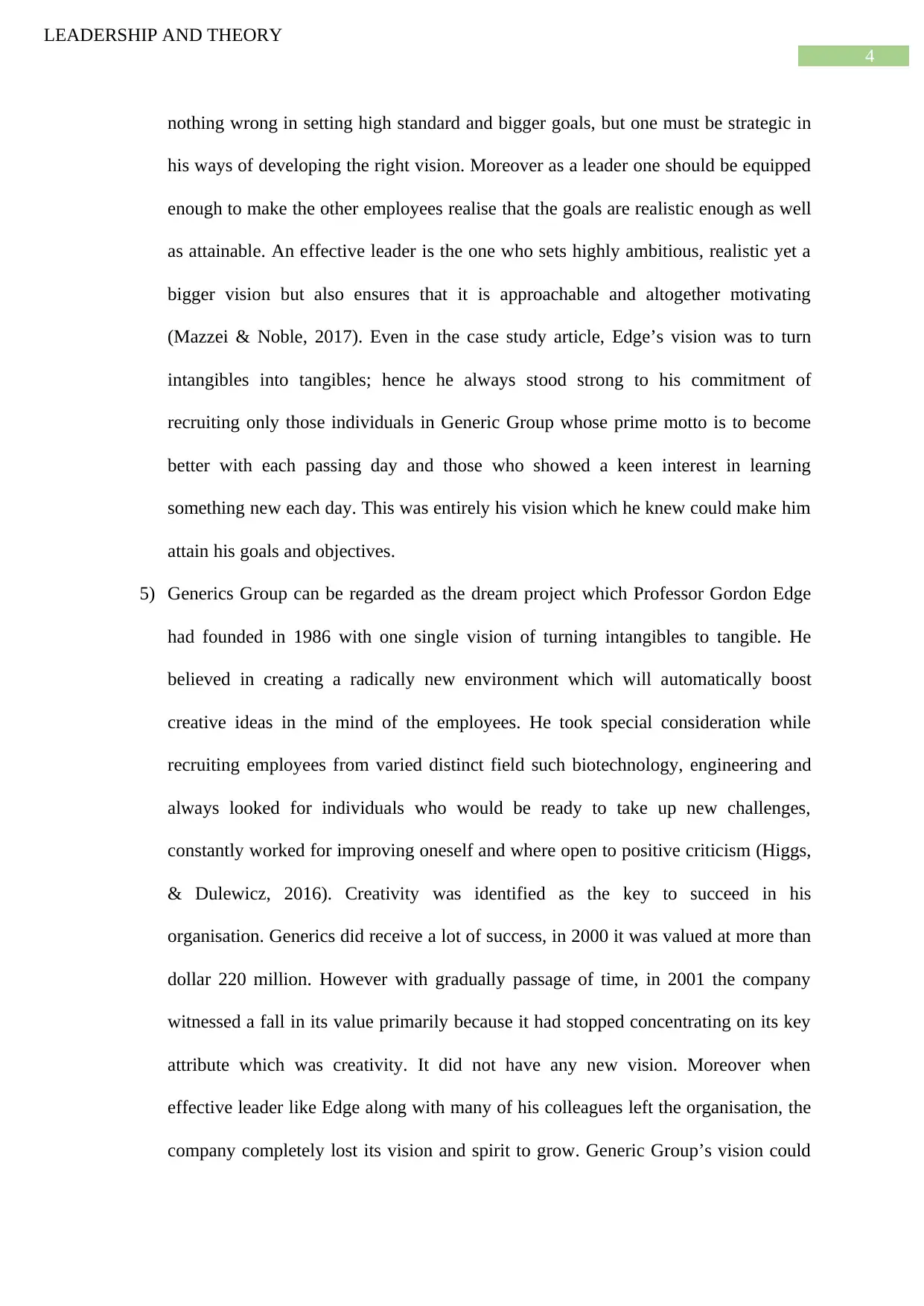
4
LEADERSHIP AND THEORY
nothing wrong in setting high standard and bigger goals, but one must be strategic in
his ways of developing the right vision. Moreover as a leader one should be equipped
enough to make the other employees realise that the goals are realistic enough as well
as attainable. An effective leader is the one who sets highly ambitious, realistic yet a
bigger vision but also ensures that it is approachable and altogether motivating
(Mazzei & Noble, 2017). Even in the case study article, Edge’s vision was to turn
intangibles into tangibles; hence he always stood strong to his commitment of
recruiting only those individuals in Generic Group whose prime motto is to become
better with each passing day and those who showed a keen interest in learning
something new each day. This was entirely his vision which he knew could make him
attain his goals and objectives.
5) Generics Group can be regarded as the dream project which Professor Gordon Edge
had founded in 1986 with one single vision of turning intangibles to tangible. He
believed in creating a radically new environment which will automatically boost
creative ideas in the mind of the employees. He took special consideration while
recruiting employees from varied distinct field such biotechnology, engineering and
always looked for individuals who would be ready to take up new challenges,
constantly worked for improving oneself and where open to positive criticism (Higgs,
& Dulewicz, 2016). Creativity was identified as the key to succeed in his
organisation. Generics did receive a lot of success, in 2000 it was valued at more than
dollar 220 million. However with gradually passage of time, in 2001 the company
witnessed a fall in its value primarily because it had stopped concentrating on its key
attribute which was creativity. It did not have any new vision. Moreover when
effective leader like Edge along with many of his colleagues left the organisation, the
company completely lost its vision and spirit to grow. Generic Group’s vision could
LEADERSHIP AND THEORY
nothing wrong in setting high standard and bigger goals, but one must be strategic in
his ways of developing the right vision. Moreover as a leader one should be equipped
enough to make the other employees realise that the goals are realistic enough as well
as attainable. An effective leader is the one who sets highly ambitious, realistic yet a
bigger vision but also ensures that it is approachable and altogether motivating
(Mazzei & Noble, 2017). Even in the case study article, Edge’s vision was to turn
intangibles into tangibles; hence he always stood strong to his commitment of
recruiting only those individuals in Generic Group whose prime motto is to become
better with each passing day and those who showed a keen interest in learning
something new each day. This was entirely his vision which he knew could make him
attain his goals and objectives.
5) Generics Group can be regarded as the dream project which Professor Gordon Edge
had founded in 1986 with one single vision of turning intangibles to tangible. He
believed in creating a radically new environment which will automatically boost
creative ideas in the mind of the employees. He took special consideration while
recruiting employees from varied distinct field such biotechnology, engineering and
always looked for individuals who would be ready to take up new challenges,
constantly worked for improving oneself and where open to positive criticism (Higgs,
& Dulewicz, 2016). Creativity was identified as the key to succeed in his
organisation. Generics did receive a lot of success, in 2000 it was valued at more than
dollar 220 million. However with gradually passage of time, in 2001 the company
witnessed a fall in its value primarily because it had stopped concentrating on its key
attribute which was creativity. It did not have any new vision. Moreover when
effective leader like Edge along with many of his colleagues left the organisation, the
company completely lost its vision and spirit to grow. Generic Group’s vision could
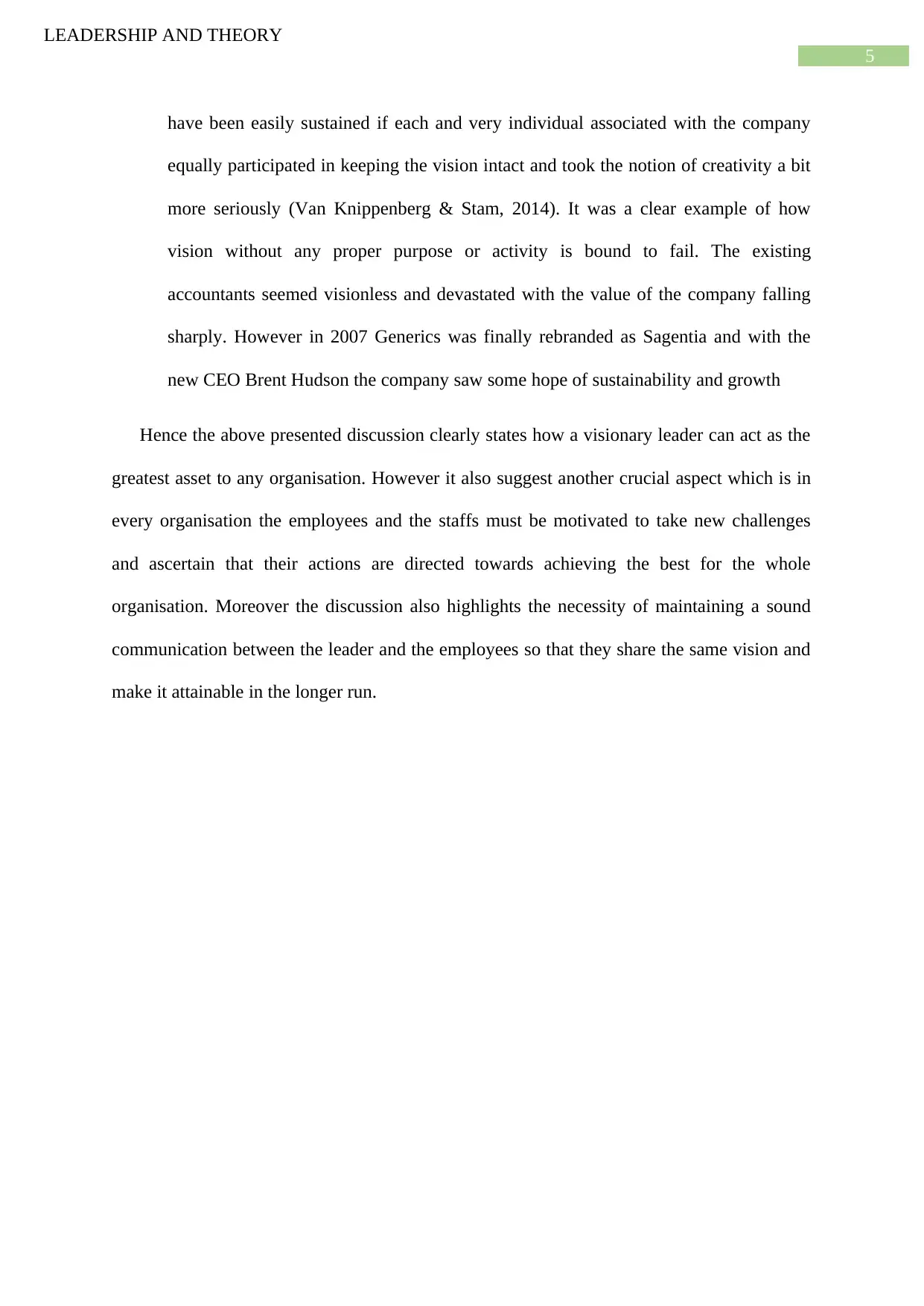
5
LEADERSHIP AND THEORY
have been easily sustained if each and very individual associated with the company
equally participated in keeping the vision intact and took the notion of creativity a bit
more seriously (Van Knippenberg & Stam, 2014). It was a clear example of how
vision without any proper purpose or activity is bound to fail. The existing
accountants seemed visionless and devastated with the value of the company falling
sharply. However in 2007 Generics was finally rebranded as Sagentia and with the
new CEO Brent Hudson the company saw some hope of sustainability and growth
Hence the above presented discussion clearly states how a visionary leader can act as the
greatest asset to any organisation. However it also suggest another crucial aspect which is in
every organisation the employees and the staffs must be motivated to take new challenges
and ascertain that their actions are directed towards achieving the best for the whole
organisation. Moreover the discussion also highlights the necessity of maintaining a sound
communication between the leader and the employees so that they share the same vision and
make it attainable in the longer run.
LEADERSHIP AND THEORY
have been easily sustained if each and very individual associated with the company
equally participated in keeping the vision intact and took the notion of creativity a bit
more seriously (Van Knippenberg & Stam, 2014). It was a clear example of how
vision without any proper purpose or activity is bound to fail. The existing
accountants seemed visionless and devastated with the value of the company falling
sharply. However in 2007 Generics was finally rebranded as Sagentia and with the
new CEO Brent Hudson the company saw some hope of sustainability and growth
Hence the above presented discussion clearly states how a visionary leader can act as the
greatest asset to any organisation. However it also suggest another crucial aspect which is in
every organisation the employees and the staffs must be motivated to take new challenges
and ascertain that their actions are directed towards achieving the best for the whole
organisation. Moreover the discussion also highlights the necessity of maintaining a sound
communication between the leader and the employees so that they share the same vision and
make it attainable in the longer run.
⊘ This is a preview!⊘
Do you want full access?
Subscribe today to unlock all pages.

Trusted by 1+ million students worldwide
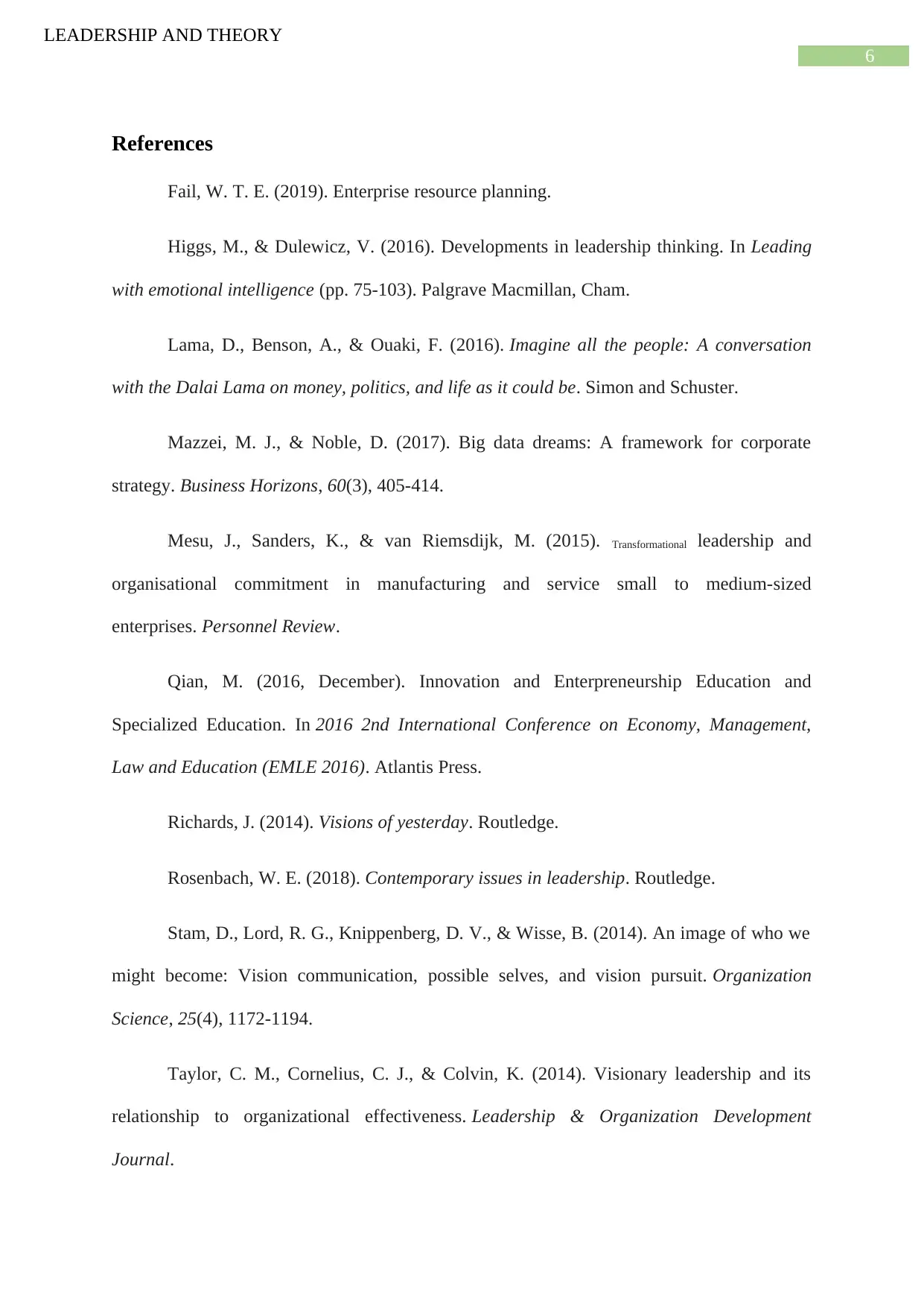
6
LEADERSHIP AND THEORY
References
Fail, W. T. E. (2019). Enterprise resource planning.
Higgs, M., & Dulewicz, V. (2016). Developments in leadership thinking. In Leading
with emotional intelligence (pp. 75-103). Palgrave Macmillan, Cham.
Lama, D., Benson, A., & Ouaki, F. (2016). Imagine all the people: A conversation
with the Dalai Lama on money, politics, and life as it could be. Simon and Schuster.
Mazzei, M. J., & Noble, D. (2017). Big data dreams: A framework for corporate
strategy. Business Horizons, 60(3), 405-414.
Mesu, J., Sanders, K., & van Riemsdijk, M. (2015). Transformational leadership and
organisational commitment in manufacturing and service small to medium-sized
enterprises. Personnel Review.
Qian, M. (2016, December). Innovation and Enterpreneurship Education and
Specialized Education. In 2016 2nd International Conference on Economy, Management,
Law and Education (EMLE 2016). Atlantis Press.
Richards, J. (2014). Visions of yesterday. Routledge.
Rosenbach, W. E. (2018). Contemporary issues in leadership. Routledge.
Stam, D., Lord, R. G., Knippenberg, D. V., & Wisse, B. (2014). An image of who we
might become: Vision communication, possible selves, and vision pursuit. Organization
Science, 25(4), 1172-1194.
Taylor, C. M., Cornelius, C. J., & Colvin, K. (2014). Visionary leadership and its
relationship to organizational effectiveness. Leadership & Organization Development
Journal.
LEADERSHIP AND THEORY
References
Fail, W. T. E. (2019). Enterprise resource planning.
Higgs, M., & Dulewicz, V. (2016). Developments in leadership thinking. In Leading
with emotional intelligence (pp. 75-103). Palgrave Macmillan, Cham.
Lama, D., Benson, A., & Ouaki, F. (2016). Imagine all the people: A conversation
with the Dalai Lama on money, politics, and life as it could be. Simon and Schuster.
Mazzei, M. J., & Noble, D. (2017). Big data dreams: A framework for corporate
strategy. Business Horizons, 60(3), 405-414.
Mesu, J., Sanders, K., & van Riemsdijk, M. (2015). Transformational leadership and
organisational commitment in manufacturing and service small to medium-sized
enterprises. Personnel Review.
Qian, M. (2016, December). Innovation and Enterpreneurship Education and
Specialized Education. In 2016 2nd International Conference on Economy, Management,
Law and Education (EMLE 2016). Atlantis Press.
Richards, J. (2014). Visions of yesterday. Routledge.
Rosenbach, W. E. (2018). Contemporary issues in leadership. Routledge.
Stam, D., Lord, R. G., Knippenberg, D. V., & Wisse, B. (2014). An image of who we
might become: Vision communication, possible selves, and vision pursuit. Organization
Science, 25(4), 1172-1194.
Taylor, C. M., Cornelius, C. J., & Colvin, K. (2014). Visionary leadership and its
relationship to organizational effectiveness. Leadership & Organization Development
Journal.
Paraphrase This Document
Need a fresh take? Get an instant paraphrase of this document with our AI Paraphraser
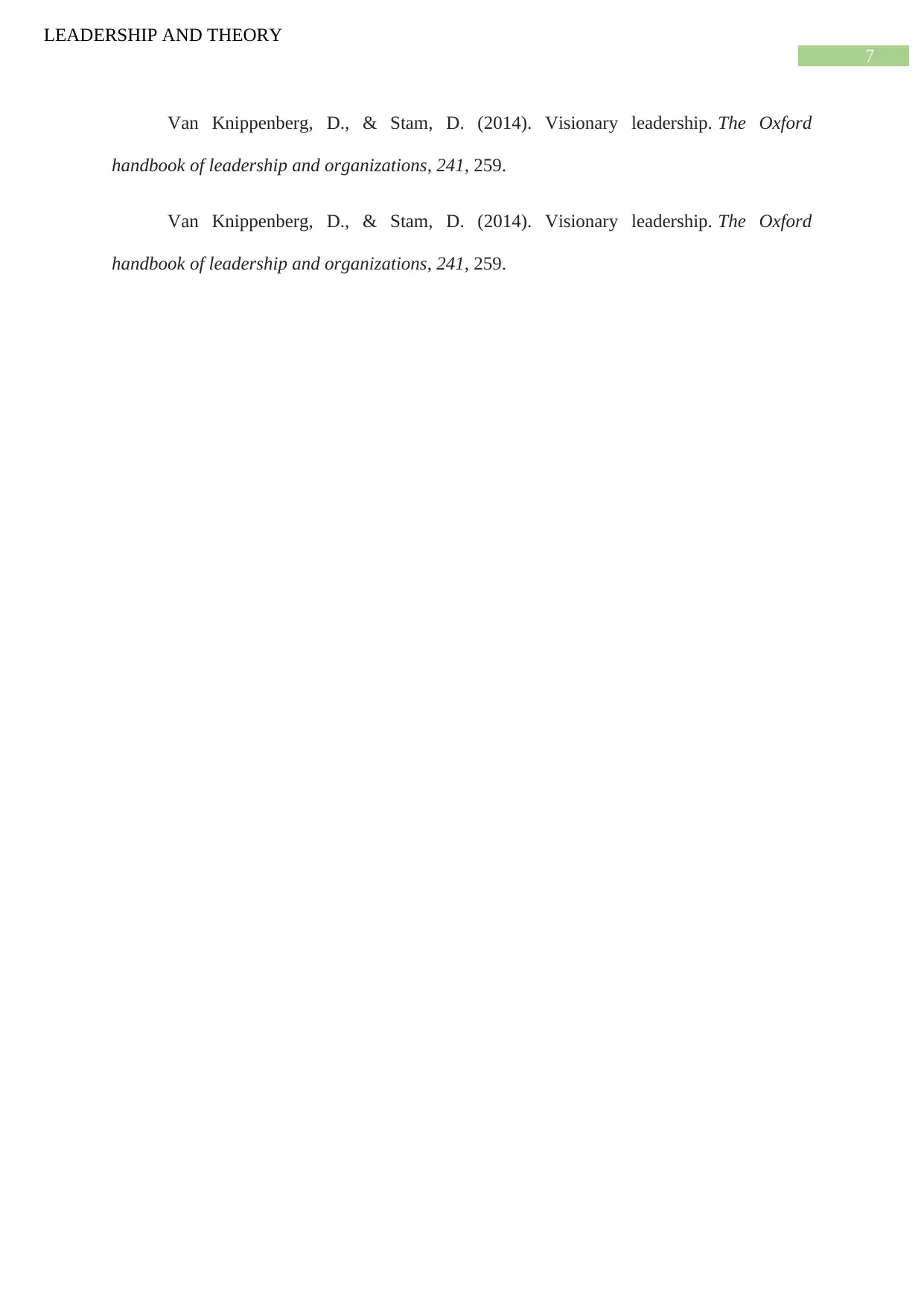
7
LEADERSHIP AND THEORY
Van Knippenberg, D., & Stam, D. (2014). Visionary leadership. The Oxford
handbook of leadership and organizations, 241, 259.
Van Knippenberg, D., & Stam, D. (2014). Visionary leadership. The Oxford
handbook of leadership and organizations, 241, 259.
LEADERSHIP AND THEORY
Van Knippenberg, D., & Stam, D. (2014). Visionary leadership. The Oxford
handbook of leadership and organizations, 241, 259.
Van Knippenberg, D., & Stam, D. (2014). Visionary leadership. The Oxford
handbook of leadership and organizations, 241, 259.
1 out of 8
Related Documents
Your All-in-One AI-Powered Toolkit for Academic Success.
+13062052269
info@desklib.com
Available 24*7 on WhatsApp / Email
![[object Object]](/_next/static/media/star-bottom.7253800d.svg)
Unlock your academic potential
Copyright © 2020–2025 A2Z Services. All Rights Reserved. Developed and managed by ZUCOL.





